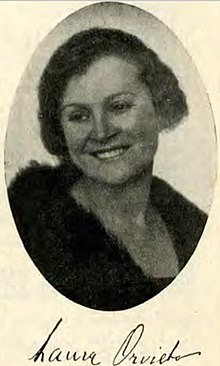
Laura Orvieto, born Laura Cantoni (7 March 1876 - 9 May 1953) was a Jewish Italian writer, intellectual and women's rights activist. Many of her most known works were written for children to teach them ancient Greek and Roman myths.

Laura Orvieto, born Laura Cantoni (7 March 1876 - 9 May 1953) was a Jewish Italian writer, intellectual and women's rights activist. Many of her most known works were written for children to teach them ancient Greek and Roman myths.
Laura Cantoni was born on 7 March 1867, in Milan, daughter of Achille Cantoni and Maria Cantoni. [1] The family was Jewish and her father, who was originally from Mantua, was a banker, a collector of antiquities, and an expert on Islamic art and history. [2] She was descended of Abramo Errera, a Venetian legislator and banker, who had worked to create socio-political equality for the Jewish community of Venice when it was freed from Austrian rule. [3] [4] She attended a girls' school which provided her with the traditional superficial education given to middle-class girls of her era. As a teenager, her parents hired a Scottish tutor, Lily Marshall, who introduced Cantoni to English literature as well as the social issues that were the focus of women's rights organizations. [5]
Cantoni became committed to women's issues and befriended women like teachers and writers Rosa Errera and Lina Schwartz. She volunteered as a teacher at the Associazione Scuola e Famiglia (School and Family Association), [5] an organization founded by the sisters Paola and Gina Lombroso as an after-school program and nursery for working-class mothers and supported by the Unione Femminile Nazionale (National Women's Union). [6] [7] Her work at the association often involved telling stories to children and she became adept at inventing impromptu narratives by merging plots from various fairy tales with her own imagination. She moved to Florence in 1899, after marrying poet Angiolo Orvieto. Having insufficient intellectual stimuli after giving birth to Leonfrancesco in 1900 and Annalia in 1903, she was encouraged to write by her husband. [1]
Orvieto began collaborating with the magazine "Il Marzocco" under the name of "Mrs. El". [1] The pseudonym was necessary because many of the articles she wrote addressed taboo topics like gender relationships, women's labor problems, and rights for women to have education and be politically engaged. [8] In 1909, she published her first book, Leo and Lia and two years later Storie della storia del mondo ("Stories of World History"), which would become her most known work. [9] Several of her books for children were translated into other languages and had multiple editions. [1] She was a friend of the Italian writer Amelia Pincherle Rosselli and of the actress Eleonora Duse, who she met through the Florentine Lyceum. [1] Lyceum clubs were organized throughout Europe as professional networking organizations for women. Membership was limited to women who had university qualifications or had published original art, music, writing, or scientific works. [10] [11] She joined the Florentine branch of the Consiglio Nazionale delle Donne Italiane (CNDI), (National Council of Italian Women) and became friends with Bice Cammeo, Ernestina Paper and Mary Nathan Puritz. [8] During World War I, she worked as a volunteer nurse, which inspired her to write a biography of Florence Nightingale. [1]
Initially when the fascist regime came to power in Italy, Orvieto's work was not overly impacted. But beginning in 1929, her publisher Enrico Bemporad required that she make significant changes for new works and new editions, omitting references to Jews. Bemporad was Jewish, but an agreement between the fascist state and the Catholic Church meant that libraries and schools could no longer carry works in which Jews were protagonists. [12] Introduction of the Italian racial laws and legislation restricting women's right to work in 1938, further curtailed her activities. [13] [14] Those statutes required Jews to be expelled from various clubs, and officially women were excluded from working or contributing to culture or social services as volunteers. [13] [15] During this time, she intentionally focused on Jewish topics, writing an autobiography and an unpublished novel, Leone Da Rimini. [16] Between 1943 and 1945, Orvieto and Angiolo went into hiding, living in an elder care home in Mugello. [17] When the war ended, she founded a children's journal, La settimana dei ragazzi (The Children's Week), which she operated until 1947. [1] [18]
Some of her books were illustrated by Ezio Anichini 's Art Nouveau lithographies.
Orvieto died on 9 March 1953, in Florence. [1] She is most remembered for her series of works on the myths of the Greeks and Romans, writing the stories in clear plain language directed at children. [19]
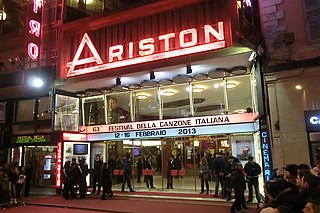
The Sanremo Music Festival, officially the Italian Song Festival, is the most popular Italian song contest and awards ceremony, held annually in the city of Sanremo, Liguria, organized and broadcast by Italian public broadcaster RAI. It is the longest-running annual TV music competition in the world on a national level and it is also the basis and inspiration for the annual Eurovision Song Contest.
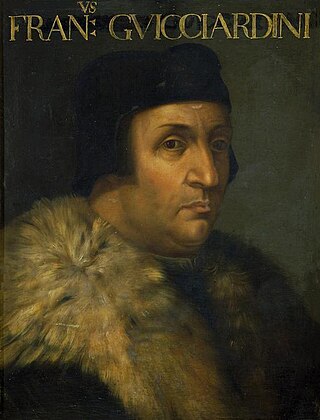
Francesco Guicciardini was an Italian historian and statesman. A friend and critic of Niccolò Machiavelli, he is considered one of the major political writers of the Italian Renaissance. In his masterpiece, The History of Italy, Guicciardini paved the way for a new style in historiography with his use of government sources to support arguments and the realistic analysis of the people and events of his time.
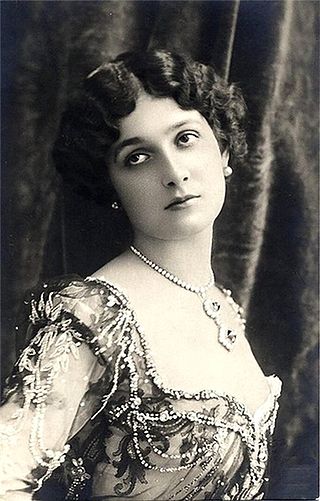
Natalina "Lina" Cavalieri was an Italian operatic dramatic soprano, actress, and monologist.

Virginia de' Medici was an Italian princess, a member of the House of Medici and by marriage Duchess of Modena and Reggio.

Cordula "Lina" Poletti was an Italian writer, poet, playwright, and feminist. Often described as beautiful and rebellious, she was prone to wear men's clothing and is considered one of the first women in Italy to openly declare her lesbianism.

Angiolino or Angiolo Romagnoli was an Italian painter, mainly of genre subjects. He was part of the Macchiaioli painters who convened at the Caffe Michelangiolo. He is known for his fresco decorations meant to imitate Renaissance tapestries.

DonnaVirginia Bourbon del Monte dei principi di San Faustino was the wife of Edoardo Agnelli and the mother of Gianni Agnelli.

Baldassarre di Biagio, also called Baldassarre di Biagio del Firenze or the Master of the Benabbio Triptych, (1430/1434–1484) was an Italian painter of the high Renaissance period.

Hercules Strangling the Nemean Lion is a bronze sculpture located in the Piazza Ognissanti, overlooking the River Arno in Florence, Italy.
Viviana Mazza is a writer and a journalist at the foreign desk for the Italian daily newspaper Corriere della Sera. At Corriere she specializes in covering the United States and the Middle East. She has also covered, among other countries, Pakistan, Afghanistan and Nigeria. She edits the America-Cina newsletter and contributes to the La27Ora blog.

Medea Vittoria Irma Norsa (1877–1952) was an Italian papyrologist and philologist. She headed the Istituto Papirologico Girolamo Vitelli in Florence from 1935 to 1949.
Cassa di Risparmio di Orvieto S.p.A. is an Italian bank based in Orvieto, in the Province of Terni, Umbria.
Laura Mancinelli was an Italian writer, Germanist, medievalist and university professor.
Emilia Errera (1866–1901) was an Italian teacher and writer who specialized in historical and literary essays and critiques, notably about Charles Dickens.
Rosa Errera was an Italian writer, translator, and teacher. Her most well known work, published in 1921, was about the poet Dante Alighieri.
Luisa Giaconi was an Italian poet. Her work represents one of the most significant expressions of Italian symbolism in women's writing, projected towards the new sensibilities of the twentieth-century.
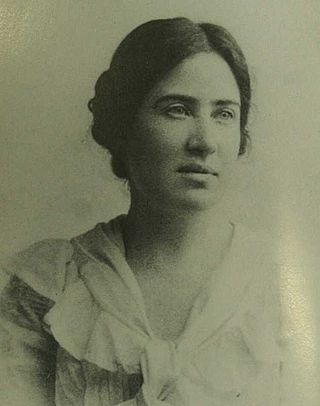
Gina Elena Zefora Lombroso was an Italian physician, writer, psychiatrist, and criminologist, best remembered for her uncredited writings on the subjects of criminology and psychiatry co-authored with her father Cesare Lombroso, her individual writings on the female condition and industrialisation. She was the wife of Italian historian and writer Guglielmo Ferrero (1871–1942) and hence adopted the surname Ferrero-Lombroso. Their son Leo Ferrero (1903–1933), a writer and playwright, died in a car accident in Santa Fe (USA). All three are buried at the Cimetière des Rois in Geneva, Switzerland.
Eugenia Levi was an Italian writer, translator, and journalist. Born to a Jewish family in Padua, she was educated in that city, as well as in Florence and Hanover. In 1885 she was appointed professor at the R. Istituto superiore femminile di Magistero in Florence.
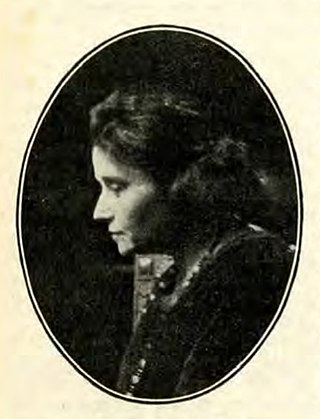
Virginia Tango Piatti was an Italian writer, pacifist, anti-fascist, and women's rights activist. Born in Florence, the family settled in Rome in 1897, where she was briefly schooled by nuns. She moved to Milan in 1904 to help with the education of her sister's children and met the painter Antonio Piatti, whom she married in 1905. Although she had begun writing around the time of her marriage, it became her livelihood in 1911, when she separated from her husband. She adopted the pen name Agar at that time, publishing poems, children's stories and articles about pacifism in various journals. Her outspokenness against fascism led to her registration as a subversive and her self-exile to Paris.

Lina Schwarz was an Italian writer, educator, and pacifist. Born into a Jewish family living in Verona, she spent most of her life in Milan. As a result of participating in the women's rights movement in Italy, she became involved in helping disadvantaged children through civic works projects. Teaching children to read led to her becoming a well-known children's book author and a contributor to children's newspapers. She collaborated with musicians to set poems to music, recognizing the potential to increase learning through song. Many of the nursery rhymes known and recited by Italians were written by Schwarz. Although her poem "Stella, stellina, la notte si avvicina" is widely known in Italy, her authorship of it was lost after World War II ended.